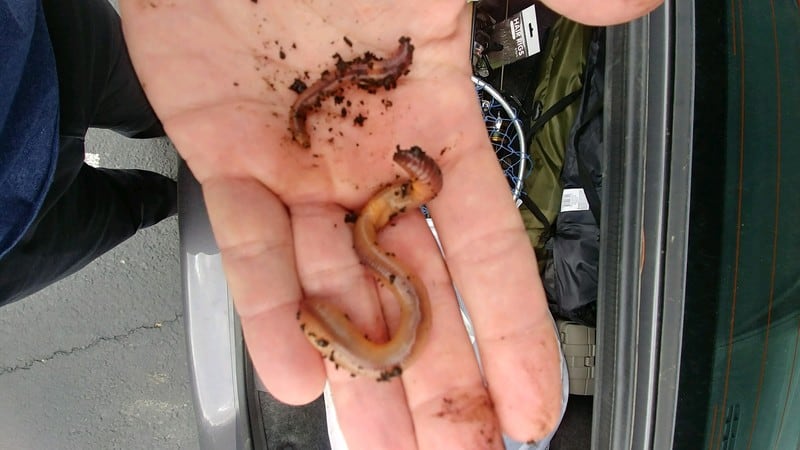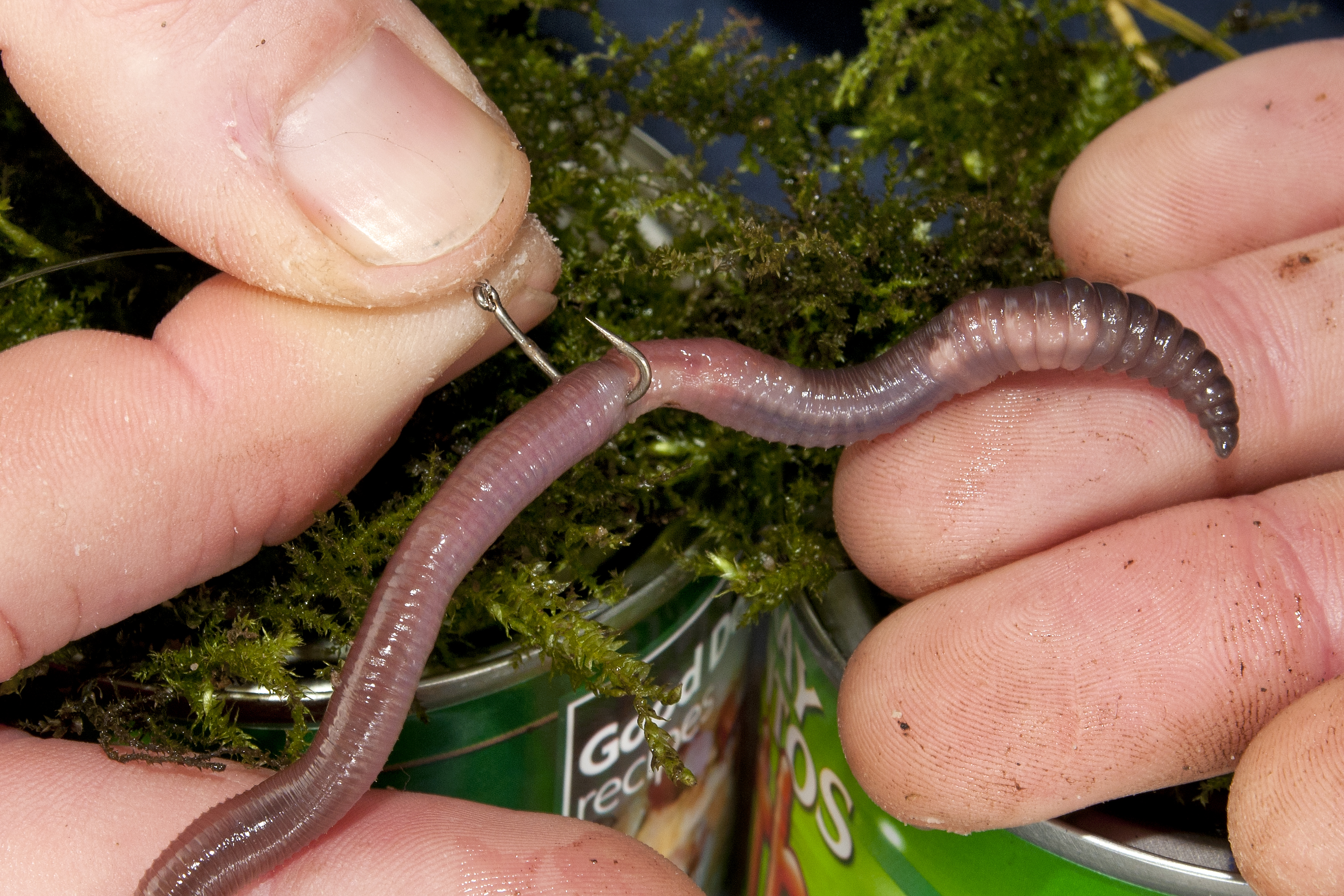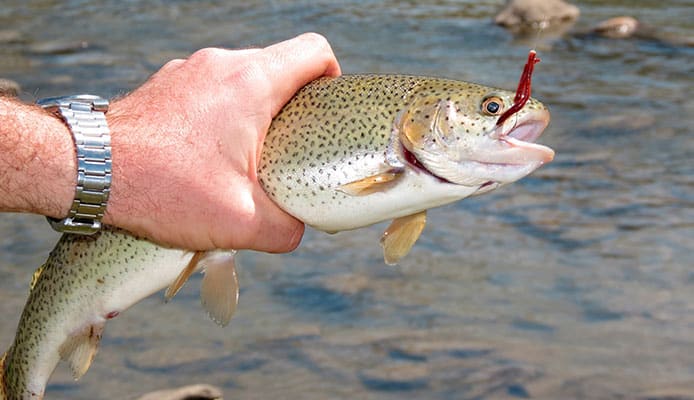When most people think of trout fishing, they think of bait – typically a worm or larvae of some kind. Most people also think that you need to use live bait, but this is not the case. In fact, when it comes to trout fishing, there are many different types of bait that can be used – both live and artificial. So, if you’re looking to catch some trout, here’s a guide on how to bait a worm on the hook for trout.
Contents
Fishing With Live Worms
Fishing with live worms is a great idea if you want to catch fish. The most effective time for this method would be after rains or in the spring and early summer season, when there are lots of trout around that, prefer eating those tasty little bugs!
It’s no surprise that trout and steelhead love worms, they are a big meal that is hard for them to resist.
Worms will come up to the surface under heavy rains or after dark and they could wander around on top. The best way for you to know if there is a wormer near your feet, try stickering them with something that has been discovered by someone else first!
Live trout worms are a little more difficult to use than dead ones, but it’s worth the extra effort. The best way is with slow lobs and by hooking them so that they stay on your line rather than falling off after one cast like most people do when using live baits in water too shallow for casting without holding onto their rod too tightly or having any tension at all.
Hook your trout worm into a ball or blob of worms, not the long ribbon-like shapes that they naturally produce. The natural shape of these insects is to be seen tumbling down rivers rather than floating in straight lines as if on strings! You need this “natural” appearance so you can fool any fish into thinking it’s an easy catch – but don’t forget about all those little details like how high upriver it’s been cast and where around its body there are hooks attached (just ask me if I know!).
When fishing for trout, make sure you use the right technique and equipment. If you are not skilled enough to throw a real fishworm without it flying off all of the time then I highly recommend using plastic ones instead!

What is the best type of worm for trout fishing?
Trout fishing generally involves two basic types of worms – dew and common. The size difference between them can be quite significant, with fat 10-inches usually too much for small fish but not ideal on large ones like rainbows or browns in my experience. 2 – 3 inch long garden variety red wigglers work better overall as they’re just short enough without being so tiny that you’ll get frustrated trying to land them when bassin’ around if that’s what your after!
In tough fishing, it is hard to beat the real thing. The exception would be when dirty water makes larger dew worms easier to see or if you have an average size trout that wants something smaller for its dinner menu–then go with one of those plastic toy-looking things called “dew worms.” I always recommend using them during nighttime catches because big browns often only come then while all lights are off nearby!
Hooks For Worms
There are many books out there that will suit your fishing needs, but not all of them work for every situation. A hook should be strong enough to hold up against the weight and drag from the water current as well as being large enough so it doesn’t get seen by fish right away or cause any damage when they bite on it! For bigger basses like dew worms (that come with a 6″ mouth), I use size 10s while smaller plastics such as 3-inch TROUT WORMS need only have 9/0 circle hooks attached.
For trout worms, use a size 12 Raven Hook or 10 Gamakatsu hook. For plastic ones around 3 inches try either one of those two choices – depending on what kind you have available at the moment!
How to hook a live worm
- Store your live worms in a cool place so they don’t spoil. Keep them away from sunlight, which makes the taste unpleasant for fish prey-cards such as trout!
- Some people like to take the time before they pick up a wiggling earthworm and rub some dirt on their fingertips. This not only helps hide any scents from insect sunscreen but also makes grabbing hold of those little guys easier!
- Cutting the worm into smaller pieces may be more appetizing for trout. However, it is important not to cut too much because then you’ll have a whole lot of little bits and they won’t look as nice in your catch!
- The most popular way to rig a hook is going right through the head and out again. For an even more active fish, consider rigging it whacky style with your bait beneath their mouth on top of them!
- Hooking the worm is a lot like fishing with two different rods and reels. One reel holds your bait, which could be anything from an earthworm’s leg to some wobbling grasshopper paws; this arm of the contraption has hooks on it for catching fish! The other side – called “dressing” or presentation – sends out little ropes that attempt persuasion through movement instead of sheer loudness (like when someone goes: “Hey you over there!”). Presentation techniques vary depending upon where they’re used in relation t whether the bass is encountered primarily deep underwater versus near shoreline waters…
How to Bait a Worm on the Hook for Trout
Trout are selective eaters, so only the largest trout can handle a full nightcrawler. For smaller fish that want to play around with their food before eating it – go for 1/2 or even just one-third!
Hook Needed: j-hook or bait hook; size 8 through 1

Gamakatsu Baitholder Hook
Put up with Gamakatsu’s top-of-the-line baitholder hooks for trout, you won’t be disappointed. The sharpness is just enough to get the job done without breaking or dulling quickly as other brands can do!
#Step 1
The wrong fishing hook can cause you a great deal of pain and suffering. Ensure that the one you choose will work for what type or size fish it is meant to catch by consulting our article above!
Knot the hook onto your line using whichever method suits you best. For a more secure knot, I recommend doubling over with an overhand Knot but find myself being lazy and just doing it in quadruple because they’re so easy to tie! Make sure that when securing both ends of this connection by pulling firmly on them while connecting at each endpoint – do not cut off any tag-end strings from around it either since we will need those later if needed for whatever reason or else simply trimming away excess cord near our gear.
#Step 2
Grab a live red worm or nightcrawler from your container.
When fishing for trout, break the nightcrawler in half or keep it fully intact.
#Step 3
When you run the point of your hook through a fish’s favorite hole, that will be one more pore for them to catch scents from. I recommend leaving some free worms at both ends so they can wiggle around while enticing hungry trout with their motion!
#Step 4
When fishing in strong currents, add split shot lead weights to sink your bait and make it more difficult for fish to find hiding under rocks. The weight should be attached 4-8 inches above the bottom so that when you reel back on that line there’s no question about where they’re going!
Another way to help you find more fish is by adding a bobber or strike indicator float. These can detect subtle bites that may be missed with just your line, so they’re great for catching those hard-to-spot creatures!
#Step 5
Use these worm-baited hooks in areas of water where trout can be found. The fish prefer to hang out near the slower-moving current and eddies, so you should use them there!
Best times and when to fish a worm bait?
Trout are not picky about their food. They will eat anything that is offered to them, including worms – any time of the year and in almost any type or condition!
Now is a great time to fish for river trout after rain. Many worms leave their boles and end up in the rivers when waters rise high enough after heavy storms or during spring rains that they cannot go back into the dry ground anymore — so any who may be looking are likely going down seeking some tasty grub!
When the water is dirty, trout are more likely to hunt by sight rather than sound. That’s why you need a bait that vibrates instead of one who swings around like an idiot; because it will be easier for them to see what they’re eating! This isn’t some kind of drifting worm either-I mean straight-up slow drops with no wiggles at all (unless we tell ‘em how).
Trout are difficult to catch when water temperatures soar. If you want a few stock trout for your dining table, try fishing with worms instead of other types of prey that may be more enticing but don’t necessarily make good food options – eels and hail example!
When the water gets very cold, trout are hard to catch because they have less energy. To make up for this lack of vitality in colder weather conditions where you’re fishing with enticing lures or fly rods and flies that would be difficult at best if not impossible otherwise–fish Omelette! Fat juicy worms provide both nutrients AND weight; which means more food on your line than ever before while still being able to enjoy some tasty treats to boot.
FAQs
Q: What to do with your hands?
Worms are one of the most popular baits for catching fish, but I’ve read that some people recommend making sure you don’t have human smells on your hands or washing them in order to get better results. Other articles suggested either cold-water hand scrubbing before grabbing a worm as well as soap usage – both suggestions which make sense if taken literally; however they seem more focused on creating content rather than providing helpful advice (i..e., there isn’t really anything new). In contrast, this report simply states “Warm up,” recommends using fewer steps. It’s easy to get caught up in the intricacies of fishing, but it’s important not to do so. Just remember: cast your line and bait that worm!
Q: How many worms should you put on a hook?
Leave the last quarter of your worm intact for a more interesting presentation. It will intrigue fish and make them want to bite down on it, rather than just spearing an end-of-the-line upright object into their mouth with no give or flexibility in order to attract attention from beneath the surface where most edible species live.
Q: Do worms grow back if cut in half?
Earthworms are actually pretty fascinating creatures. It’s easy to believe that they won’t survive being cut in two, but if you split an earthworm with its head still attached and leave it on its side then chances are good for regeneration of at least some part or all parts will take place!
Q: How long does a worm live?
Worms are one of the most earth-friendly creatures around! They can live for up to four years, and when they die in your bin their bodies get recycled with food scraps. Worm castings make a toxic mess out of living worms so are sure not to put them next to one’s garden or anywhere where they could end up eaten by animals.
Q: How deep do worms go in the ground?
The earthworm is a creature that can be found burrowing during the day. They typically stay close to the surface, capable of digging down 6 feet deep into the soil where they extract nutrients from decomposing organic matter like leaves and roots!
Conclusion
When you go fishing, it is important to use the right bait on your hook in order to catch a trout. If you are using a worm as bait, there are a few tips that will help you ensure that you are successful. First, make sure that the worm is healthy and lively before casting it into the water. Second, use a smaller hook so that the trout can easily take the bait without feeling resistance. Finally, cast your line close to where the trout are hiding and be patient until one takes the bait. By following these simple tips, you can increase your chances of landing a trout when fishing for them with worms.







